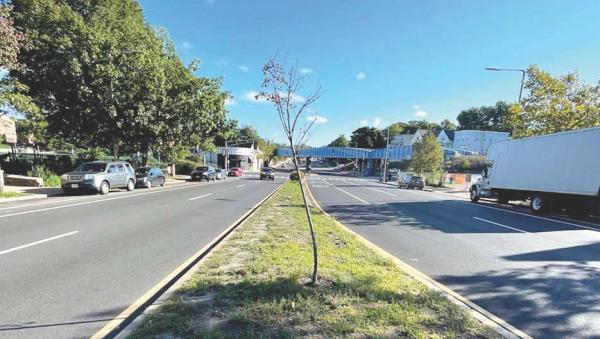September 28, 2022

A spindly tree grows in the median of Columbia Road. (Bill Walczak photo)
Mayor Michelle Wu’s “Vision for Boston’s Urban Forest” is an impressive document. The plan, at 237 pages, has specific goals, cites best practices from other cities, and has a system of evaluation toward the goal of increasing the city’s tree canopy.
Mayors Menino and Walsh also had ambitious plans to increase the canopy, neither of which came to fruition. In fact, it has decreased over the past 30 years. But given the level of detail and excitement behind it, the Wu plan might succeed.
The document, which refers to trees as “critical city infrastructure,” calls attention to why we need to increase the canopy – the public health impact in filtering pollution; mitigating heat in the summer (there can be a ten-degree difference between neighborhoods with tree cover and those without it); reducing the need for air conditioning; lessening flooding after storms; and its overall impact on physical and mental health.
The plan points out that most of the tree canopy is on privately owned land and suggests an ordinance that would preserve and increase shade trees on private property. It describes the inequity of some neighborhoods having much greater tree coverage than other neighborhoods, and how those inequities will be addressed. It’s a far-reaching, comprehensive plan, but its success will be determined by what actually happens. In that vein, I have a list of suggestions for consideration:
• The plan calls for reorganizing urban forest management and moving to pro-active maintenance. This needs to start with the Parks Department. As a 50-year resident of Boston, I’ve seen parks get major capital improvements, with little maintenance afterward, with the result that the parks deteriorate until the next capital improvement 20-30 years later. Every park in the city needs a pro-active, publicly accessible maintenance plan beyond trash pickup.
• My experience with Savin Hill Park is that whatever maintenance occurs in the upper five acres, including removal of dead trees, is from the neighborhood cleanup. Simple things, like getting the grass cut, seem difficult to impossible to sustain regularly. We should do an assessment of what every park needs, and staff accordingly. The Parks Department has been starved of sufficient staffing for many years.
• Parks Department changes should also include how the Parks Commission approves developments next to parks. The work along Alpine Way in Savin Hill went right up to the edge of the park and it included cutting tree roots and a big chunk of the puddingstone that makes up the hill. Yet the Parks Commission did not require the developers to improve the adjacent section of the park, which is filled with dead trees, overgrown vegetation, and glass.
• Street trees are another major part of the plan. How we add street trees needs to be re-conceptualized if we’re going to see a significant increase in the city’s supply. Dorchester Avenue comes to mind. The Dorchester Avenue Vision Committee came up with a plan to add 42 trees along Dorchester Avenue between Columbia Road and Freeport Street, which would require the addition of about 30 tree pits.
The plan had nearly 900 signatories on the petition that called on city government to plant the trees. One Wu administration official told me a month ago that Dorchester Avenue could not have additional tree pits because “Public Works won’t allow it.” Our main streets should have trees on both public and private property that make them both beautiful and shady. As stated in the “Urban Forest Plan,” all departments need to cooperate in improving the canopy.
• Another opportunity for tree placement would be to complete the Emerald Necklace, originally intended to go from Franklin Park to Boston Harbor via Columbia Road. Columbia Road was supposed to be a parkway like the Arborway in Jamaica Plain, but the city never finished the plan. It’s time.
• The Wu administration also needs to take on the state’s highway department. The nearly always-jammed Southeast Expressway is a major source of pollution, which affects brain development in children, and the health of adults and elders. Studies have shown that planting evergreens along highways filters out pollution. State officials need to add public health to the highway department’s mission and come up with a plan to plant a wall of evergreen trees along the highways that go through Boston’s neighborhoods.
• The administration should also prevail on the new governor to ensure that the rebuilding of the parkways that go through the city — such as Morrissey Boulevard and Soldiers’ Field Road — are reclaimed as parkways, which were intended to have trees and other foliage, and be for pedestrians and bicycles as well as cars.
• Finally, the “Urban Forest Plan” calls for the creation of new space for trees. There are opportunities to return lost tree space to Franklin Park and preserve tree space in Hyde Park. Franklin Park lost 13 acres in creating the Shattuck Hospital in 1949; that precious green space will become available when the hospital is demolished in 2024. In Hyde Park, 24 acres of trees known as Crane’s Ledge need protection from development.
The heat experienced this past summer should result in support for the “Vision for Boston’s Urban Forest.” This is just one part, but a major part, of what Boston needs to do to ensure that the city is livable for future generations.
Bill Walczak lives in Dorchester. His column appears regularly in the Reporter.


